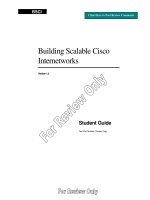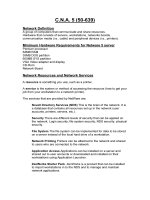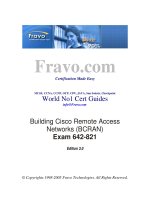IPv6 @ Cisco ppt
Bạn đang xem bản rút gọn của tài liệu. Xem và tải ngay bản đầy đủ của tài liệu tại đây (781.04 KB, 68 trang )
1
IPv6 @ Cisco
Patrick Grossetete
Cisco Systems
Cisco IOS IPv6 Product Manager
Ansar Pasha
Cisco Systems
Network Consultant,
Govt & Defense, South
Presentation_ID 222
Agenda
•
IPv6 Business Case
•
IPv6 Protocols & Standards
IPv6 Protocols & Standards
•
Integration and Transition
•
Cisco IOS IPv6 Roadmap
•
IPv6 Deployment scenarios
•
References
References
Presentation_ID 333
IPv6 - So what’s really changed ?!
•
Expanded Address Space
Address length quadrupled to 16 bytes
•
Header Format Simplification
Fixed length, optional headers are daisy-chained
IPv6 header is twice as long (40 bytes) as IPv4 header without options (20 bytes)
•
No checksumming at the IP network layer
•
No hop-by-hop segmentation
Path MTU discovery
•
64 bits aligned
•
Authentication and Privacy Capabilities
IPsec is mandated
•
No more broadcast
Presentation_ID 444
IPv4 & IPv6 Header Comparison
Version IHL Type of Service Total Length
Identification Flags
Fragment
Offset
Time to Live Protocol Header Checksum
Source Address
Destination Address
Options Padding
Version Traffic Class Flow Label
Payload Length
Next
Header
Hop Limit
Source Address
Destination Address
IPv4 Header
IPv4 Header
IPv6
Header
Header
- field’s name kept from IPv4 to IPv6
- fields not kept in IPv6
- Name & position changed in IPv6
- New field in IPv6
Legend
Presentation_ID 555
How Was IPv6 Address Size Chosen?
•
Some wanted fixed-length, 64-bit addresses
Easily good for 10
12
sites, 10
15
nodes, at .0001 allocation
efficiency (3 orders of magnitude more than IPv6
requirement)
Minimizes growth of per-packet header overhead
Efficient for software processing
•
Some wanted variable-length, up to 160 bits
Compatible with OSI NSAP addressing plans
Big enough for auto-configuration using IEEE 802 addresses
Could start with addresses shorter than 64 bits & grow later
•
Settled on fixed-length, 128-bit addresses
(340,282,366,920,938,463,463,374,607,431,768,211,456 in all!)
Presentation_ID 666
IPv6 Addressing
•
IPv6 Addressing rules are covered by multiples RFC’s
Architecture defined by RFC 3513 (obsoletes RFC 2373)
•
Address Types are :
Unicast : One to One (Global, Link local, Site local, Compatible)
Anycast : One to Nearest (Allocated from Unicast)
Multicast : One to Many
Reserved
•
A single interface may be assigned multiple IPv6
addresses of any type (unicast, anycast, multicast)
No Broadcast Address -> Use Multicast
Presentation_ID 777
IPv6 Address Representation
•
16-bit fields in case insensitive colon hexadecimal
representation
2031:0000:130F:0000:0000:09C0:876A:130B
•
Leading zeros in a field are optional:
2031:0:130F:0:0:9C0:876A:130B
•
Successive fields of 0 represented as ::, but only once in an
address:
•
2031:0:130F::9C0:876A:130B
•
2031::130F::9C0:876A:130B
•
0:0:0:0:0:0:0:1 => ::1
•
0:0:0:0:0:0:0:0 => ::
•
IPv4-compatible address representation
•
0:0:0:0:0:0:192.168.30.1 = ::192.168.30.1 = ::C0A8:1E01
Presentation_ID 888
IPv6 Addressing
•
Prefix Format (PF) Allocation
PF = 0000 0000 : Reserved
PF = 001 : Aggregatable Global Unicast Address
PF = 1111 1110 10 : Link Local Use Addresses (FE80::/10)
PF = 1111 1110 11 : Site Local Use Addresses (FEC)::/10)
PF = 1111 1111 : Multicast Addresses (FF00::/8)
Other values are currently Unassigned (approx. 7/8th of total)
•
All Prefix Formats have to support EUI-64 bits Interface ID setting
But Multicast
Presentation_ID 999
Aggregatable Global Unicast Addresses
•
Aggregatable Global Unicast addresses are:
Addresses for generic use of IPv6
Structured as a hierarchy to keep the aggregation
•
See RFC 3513
Interface ID
Global Routing Prefix
SLA
001
64 bits3 45 bits 16 bits
Provider Site Host
Presentation_ID 101010
Address Allocation Policy
•
The allocation process is under reviewed by the Registries:
IANA allocates 2001::/16 to registries
Each registry gets a /23 prefix from IANA
Formely, all ISP were getting a /35
With the new policy, Registry allocates a /32 prefix to an IPv6 ISP
Then the ISP allocates a /48 prefix to each customer (or potentially /64)
/>2001
0410
ISP prefix
Site prefix
LAN prefix
/32
/48 /64
Registry
/23
Bootstrap process - RFC2450
Interface ID
Presentation_ID 111111
Interface IDs
•
Lowest-order 64-bit field of unicast address may be assigned in
several different ways:
–
auto-configured from a 64-bit EUI-64, or expanded
from a 48-bit MAC address (e.g., Ethernet address)
–
auto-generated pseudo-random number
(to address privacy concerns)
–
assigned via DHCP
–
manually configured
Presentation_ID 121212
IPv6 Address Privacy (RFC 3041)
•
Temporary addresses for IPv6 host client application, eg.
Web browser
Inhibit device/user tracking but is also a potential issue
More difficult to scan all IP addresses on a subnet but port
scan is identical when an address is known
Random 64 bit interface ID, run DAD before using it
Rate of change based on local policy
Implemented on Microsoft Windows XP
From RFC 3041: “…interface identifier …facilitates the
tracking of individual devices (and thus potentially users)…”
2001
0410
/32
/48 /64
/23
Interface ID
Presentation_ID 131313
Hierarchical Addressing & Aggregation
Larger address space enables:
Aggregation of prefixes announced in the global routing
table.
Efficient and scalable routing.
But current Multi-Homing schemes break the model
ISP
2001:0410::/32
Customer
no 2
IPv6 Internet
2001::/16
2001:0410:0002:/48
2001:0410:0001:/48
Customer
no 1
Only
announces
the /32
prefix
Presentation_ID 141414
•
Link-local addresses for use during auto-configuration and
when no routers are present:
•
Site-local addresses for independence from Global
Reachability, similar to IPv4 private address space
RFC3513 specifies 54 bits for SLA field but SL may get deprecated by
IPv6 WG soon
Link-Local & Site-Local Unicast
Addresses
1111 1110 10
0 interface ID
1111 1110 11
interface IDSLA*
Presentation_ID 151515
•
6to4 (RFC 3056) – WAN tunneling
•
ISATAP (Draft) – Campus tunneling
6to4 and ISATAP Addresses
2002
Public IPv4
address
/48 /64/16
Interface ID
SLA
2001
0410
ISP prefix
Site prefix
/32
/48 /64
Registry
/23
IPv4 Host address
00 00 5E FE
32 bits
32 bits
Presentation_ID 161616
Expanded Address Space
Multicast Addresses (RFC 3513)
•
Multicast is used in the context of one-to-many.
Group ID0
1111 1111
128 bits
8 bits 8 bits
FF
Scope =
1 = node
2 = link
5 = site
8 = organization
E= global
Flags
scope
Flags =
T=0 a permanent IPv6 Multicast address.
T=1 a transient IPv6 multicast address
T000 0
Presentation_ID 171717
Multicast Address Examples
•
All Nodes Addresses:
All Nodes Addresses:
FF01:0:0:0:0:0:0:1
FF02:0:0:0:0:0:0:1
•
All Routers Addresses:
All Routers Addresses:
FF01:0:0:0:0:0:0:2
FF02:0:0:0:0:0:0:2
FF05:0:0:0:0:0:0:2
•
OSPFv3:
OSPFv3:
AllSPFRouters : FF02::5
AllDRouters : FF02::6
•
Solicited-Node Address:
Solicited-Node Address:
FF02:0:0:0:0:1:FF
XX:XXXX
XX:XXXX
Concatenation of prefix FF02:0:0:0:0:1:FF00::/104 with the low-order 24 bits of an
address (unicast or anycast)
Presentation_ID 181818
more on IPv6 Addressing
80 bits 32 bits16 bits
IPv4 Address00000000……………………………0000
IPv6 Addresses with Embedded IPv4 Addresses
IPv6 Addresses with Embedded IPv4 Addresses
80 bits 32 bits16 bits
IPv4 AddressFFFF0000……………………………0000
IPv4 mapped IPv6 address
IPv4 mapped IPv6 address
Presentation_ID 191919
IPv6 Addressing Examples
LAN: 3ffe:b00:c18:1::/64
Ethernet0
MAC address: 0060.3e47.1530
router# show ipv6 interface Ethernet0
Ethernet0 is up, line protocol is up
IPv6 is enabled, link-local address is FE80::260:3EFF:FE47:1530
Global unicast address(es):
2001:410:213:1:260:3EFF:FE47:1530, subnet is 2001:410:213:1::/64
Joined group address(es):
FF02::1:FF47:1530
FF02::1
FF02::2
MTU is 1500 bytes
interface Ethernet0
ipv6 address 2001:410:213:1::/64 eui-64
Presentation_ID 202020
6BONE
•
The 6bone is an IPv6 testbed setup to assist in the
evolution and deployment of IPv6 in the Internet.
The 6bone is a virtual network layered on top of portions of the
physical IPv4-based Internet to support routing of IPv6 packets,
as that function has not yet been integrated into many
production routers. The network is composed of islands that
can directly support IPv6 packets, linked by virtual point-to-
point links called "tunnels". The tunnel endpoints are typically
workstation-class machines having operating system support
for Ipv6.
•
Over 50 countries are currently involved
•
Registry, maps and other information may be found on
/>Presentation_ID 212121
6Bone Addressing
•
6Bone address space defined in RFC2471 uses 3FFE::/16
A pTLA receives a /28 prefix
A site receives a /48 prefix
A LAN receives a /64 prefix
•
Guidelines for routing on 6bone - RFC2772
Interface ID
3ffe
pTLA prefix
site prefix
LAN prefix
/28
/48 /64
Presentation_ID 222222
6Bone Topology
•
6Bone is a test bed network with hundreds of sites from 50 countries
•
The 6Bone topology is a hierarchy of providers
•
First-level nodes are backbone nodes called pseudo Top-Level
Aggregator (pTLA)
Site
Site
pTLA
pTLA
pTL
A
pTLA
pTL
A
pTL
A
pTLA
Site
Site
Site
Site
Site
Site
Site
Site
Provider
Provider
BGP
Peering
Presentation_ID 232323
TCP Header
+ Data
IPv6 Header
Next Header
= Routing
Routing Header
Next Header = TCP
IPv6 Header Options (RFC 2460)
TCP Header
+ Data
IPv6 Header
Next Header
= TCP
IPv6 Header
Next Header
= Routing
Routing Header
Next Header =
Fragment
Fragment Header
Next Header = TCP
Fragment of
TCP Header
+ Data
•
Processed only by node identified in IPv6 Destination Address field => much lower
overhead than IPv4 options
exception: Hop-by-Hop Options header
•
Eliminated IPv4’s 40-octet limit on options
in IPv6, limit is total packet size, or Path MTU in some cases
Presentation_ID 242424
IPv6 Header Options (RFC2460)
•
Currently defined Headers should appear in the following order
IPv6 header
Hop-by-Hop Options header
Destination Options header
Routing header
Fragment header
Authentication header (RFC 1826)
Encapsulating Security Payload header (RFC 1827)
Destination Options header
upper-layer header
Presentation_ID 252525
IPv6 and Path MTU Discovery
•
Definitions:
link MTU a link’s maximum transmission unit,
path MTU the minimum MTU of all the links in a
path between a source and a destination
•
Minimum link MTU for IPv6 is 1280 octets (68 octets for IPv4)
On links with MTU < 1280, link-specific fragmentation and reassembly must be used
•
Implementations are expected to perform path MTU discovery to send packets
bigger than 1280 octets:
for each dest., start by assuming MTU of first-hop link
if a packet reaches a link in which it cannot fit, will invoke ICMP “packet too big” message to
source, reporting the link’s MTU; MTU is cached by source for specific destination
•
Minimal implementation can omit path MTU discovery as long as all packets kept ≤
1280 octets – e.g., in a boot ROM









